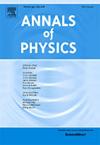Impact of extended gravity theories on accretion dynamics and observables in black hole
IF 3
3区 物理与天体物理
Q2 PHYSICS, MULTIDISCIPLINARY
引用次数: 0
Abstract
We examine a thin accretion disk surrounding a static, spherically symmetric black hole within the framework of Einstein–Gauss–Bonnet massive gravity theory. Our focus is on the motion of particles in circular orbits around the black hole in this spacetime. Specifically, we study the geodesic motion of particles confined to the equatorial plane, which contributes to the formation of the thin accretion disk, to explore their innermost stable circular orbits and energy flux distribution. To provide a comprehensive analysis of our study, we present density plots of the effective potential, specific energy, angular momentum, angular velocity, and radiation flux. The contour plots reveal that the massive gravity and Gauss–Bonnet parameters significantly influence the gravitational pull and energy dissipation within the accretion disk. These effects have important implications for the observational properties of black holes in extended gravity theories, impacting the disk’s brightness and thermal spectrum. Utilizing the well-established Novikov–Thorne model for accretion, we investigate the impact of Gauss–Bonnet and massive gravity parameters on the direct and secondary images of the black hole’s accretion disk at various observation angles. Notably, we observe significant deviations from standard black hole solutions, such as Schwarzschild or Reissner–Nordstrm.
扩展引力理论对吸积动力学和黑洞观测的影响
我们在爱因斯坦-高斯-邦纳大质量引力理论的框架内研究了一个围绕静态球对称黑洞的薄吸积盘。我们的重点是粒子在这个时空中围绕黑洞的圆形轨道上的运动。具体来说,我们研究了被限制在赤道面上的粒子的测地线运动,这有助于薄吸积盘的形成,以探索它们最内层稳定的圆形轨道和能量通量分布。为了全面分析我们的研究,我们绘制了有效势、比能、角动量、角速度和辐射通量的密度图。等高线图显示,质量引力和高斯-邦纳参数对吸积盘中的引力和能量耗散有显著影响。这些效应对扩展引力理论中黑洞的观测特性具有重要意义,影响了盘的亮度和热光谱。利用已建立的Novikov-Thorne吸积模型,研究了不同观测角度下高斯-博内和质量引力参数对黑洞吸积盘直接和二次图像的影响。值得注意的是,我们观察到与标准黑洞解(如Schwarzschild或Reissner-Nordstrm)的显著偏差。
本文章由计算机程序翻译,如有差异,请以英文原文为准。
求助全文
约1分钟内获得全文
求助全文
来源期刊

Annals of Physics
物理-物理:综合
CiteScore
5.30
自引率
3.30%
发文量
211
审稿时长
47 days
期刊介绍:
Annals of Physics presents original work in all areas of basic theoretic physics research. Ideas are developed and fully explored, and thorough treatment is given to first principles and ultimate applications. Annals of Physics emphasizes clarity and intelligibility in the articles it publishes, thus making them as accessible as possible. Readers familiar with recent developments in the field are provided with sufficient detail and background to follow the arguments and understand their significance.
The Editors of the journal cover all fields of theoretical physics. Articles published in the journal are typically longer than 20 pages.
 求助内容:
求助内容: 应助结果提醒方式:
应助结果提醒方式:


